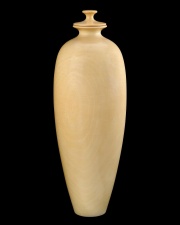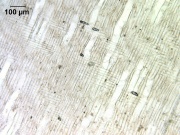Difference between revisions of "Horse chestnut"
(username removed) |
|||
| (4 intermediate revisions by 3 users not shown) | |||
| Line 1: | Line 1: | ||
| − | [[File:1994.206a-b-SC58838.jpg|thumb|]] | + | [[File:1994.206a-b-SC58838.jpg|thumb|Funerary urn<br>MFA# 1994.206]] |
== Description == | == Description == | ||
| + | [[File:25_Horse Chestnut_100x_Rad.jpg|thumb|Horse chestnut (''Aesculus hippocastanum'')]] | ||
| + | Any of several deciduous trees belonging to the genus ''Aesculus'', native to temperate regions of the northern hemisphere. Horse chestnuts are common in Europe (''A. hippocastanum'') where the large shade trees line the Champs-Élysées in Paris. Other varieties are found in Japan (''A. turbinata''), India (''A. indica'') and the U.S. (''A.glabra'', which also known as the Ohio buckeye). While primarily grown as an ornamental tree, horse chestnuts have light, soft, tough, fine-grain wood. They are used for artificial limbs, splints, and as an important source for paper pulp. The trees produce inedible, dark-color, shiny nuts in the fall that have been used as odorless mothballs. Additionally the poisonous extracts were used on spears to stun fish and animals. In the 19th century children's game called conkers, each player swung a horse chestnut on a string in an attempt to dislodge that held by their opponent. | ||
| − | |||
| − | |||
| − | |||
| − | |||
| − | |||
== Synonyms and Related Terms == | == Synonyms and Related Terms == | ||
| − | ''Aesculus hippocastanum; | + | ''Aesculus hippocastanum; Aesculus turbinata; Aesculus indica; Aesculus glabra''; tochi (Jap.) ; maronnier d'Inde (Fr.); castaño de Indias (Esp.); castanheiro da Índia (Port.); ippocastano (It.); horse-chestnut; conker; odorless mothballs; Ohio buckeye; yellow buckeye |
| − | == | + | == Risks == |
Leaves and seeds are poisonous. | Leaves and seeds are poisonous. | ||
| − | |||
| − | |||
| − | |||
| − | |||
== Additional Images == | == Additional Images == | ||
| Line 26: | Line 19: | ||
</gallery> | </gallery> | ||
| + | ==Physical and Chemical Properties== | ||
| + | * Heartwood is creamy yellow; sapwood is white; difficult to distinguish | ||
| + | * Grain is wavy or interlocked with a fine, even texture | ||
| + | |||
| + | ==Working Properties== | ||
| + | * Easy to work, but it’s low density and interlocked grain can lead to fuzzy surfaces. | ||
| + | * Glues and finishes well. | ||
| + | |||
| + | == Resources and Citations == | ||
| + | |||
| + | * The Wood Database: [https://www.wood-database.com/horse-chestnut/ Horse chestnut] | ||
| − | = | + | * Schoch, W., Heller, I., Schweingruber, F.H., Kienast, F., 2004:[http://www.woodanatomy.ch/ Wood anatomy of central European Species]: Horse Chestnut,[http://www.woodanatomy.ch/species.php?code=AEHI Aesculus hippocastaneum L.] |
* ''The American Heritage Dictionary'' or ''Encarta'', via Microsoft Bookshelf 98, Microsoft Corp., 1998 | * ''The American Heritage Dictionary'' or ''Encarta'', via Microsoft Bookshelf 98, Microsoft Corp., 1998 | ||
| − | * ''Encyclopedia Britannica'', http://www.britannica.com | + | * ''Encyclopedia Britannica'', http://www.britannica.com [Accessed December 13, 2002]. |
| − | |||
| − | |||
| + | * Museum of the Japanese Traditional Arts at http://www.nihon-kogeikai.com/ (Jap. term) | ||
[[Category:Materials database]] | [[Category:Materials database]] | ||
Latest revision as of 14:20, 9 September 2022
Description
Any of several deciduous trees belonging to the genus Aesculus, native to temperate regions of the northern hemisphere. Horse chestnuts are common in Europe (A. hippocastanum) where the large shade trees line the Champs-Élysées in Paris. Other varieties are found in Japan (A. turbinata), India (A. indica) and the U.S. (A.glabra, which also known as the Ohio buckeye). While primarily grown as an ornamental tree, horse chestnuts have light, soft, tough, fine-grain wood. They are used for artificial limbs, splints, and as an important source for paper pulp. The trees produce inedible, dark-color, shiny nuts in the fall that have been used as odorless mothballs. Additionally the poisonous extracts were used on spears to stun fish and animals. In the 19th century children's game called conkers, each player swung a horse chestnut on a string in an attempt to dislodge that held by their opponent.
Synonyms and Related Terms
Aesculus hippocastanum; Aesculus turbinata; Aesculus indica; Aesculus glabra; tochi (Jap.) ; maronnier d'Inde (Fr.); castaño de Indias (Esp.); castanheiro da Índia (Port.); ippocastano (It.); horse-chestnut; conker; odorless mothballs; Ohio buckeye; yellow buckeye
Risks
Leaves and seeds are poisonous.
Additional Images
Physical and Chemical Properties
- Heartwood is creamy yellow; sapwood is white; difficult to distinguish
- Grain is wavy or interlocked with a fine, even texture
Working Properties
- Easy to work, but it’s low density and interlocked grain can lead to fuzzy surfaces.
- Glues and finishes well.
Resources and Citations
- The Wood Database: Horse chestnut
- Schoch, W., Heller, I., Schweingruber, F.H., Kienast, F., 2004:Wood anatomy of central European Species: Horse Chestnut,Aesculus hippocastaneum L.
- The American Heritage Dictionary or Encarta, via Microsoft Bookshelf 98, Microsoft Corp., 1998
- Encyclopedia Britannica, http://www.britannica.com [Accessed December 13, 2002].
- Museum of the Japanese Traditional Arts at http://www.nihon-kogeikai.com/ (Jap. term)



